How to Diy Large Scale Canvas Doy Large Scale Art
Here's a tutorial for creating your own DIY Sheet Painting offset with a DIY Oversized Sail made out of a $xv drop cloth. This project is a very budget-friendly fashion to make high-finish-looking custom fine art.

Living in a rental, I can't invest $500+ on beautiful large-scale art because nosotros movement and then oft I would be concerned that it wouldn't have a proper place or it might get damaged in a movement. I still want beautiful art in my abode.
How to Make a Sail Painting
I've made DIY art several times earlier. I made this DIY abstract piece on plywood a couple of years ago. I've done some oversized DIY Typography Fine art and then of course the embankment impress that was hanging in the spot on the wall prior to the bandy was a photograph snapped past yours truly. After living in this domicile for over a year, I kept looking at this wall and felt like information technology needed something more impactful above the sofa.
I had been playing around with the idea of a DIY canvas painting for a few weeks but was unsure how I'd tackle it. I'd painted a plywood abstract from scrap wood earlier just for the size I wanted, I idea that would be too heavy.
Canvas was a not bad option until I started pricing bodily canvases. Even the everyman quality canvases in the largest size cost upwards of $75 and the largest size I institute still wasn't going to be big enough.
It dawned on me that we could make a canvas and paint it and then that's what nosotros did. Today is a two-part tutorial: How I built the canvas and then how to create a sheet painting.
Part one: How to Make a Sail
The canvas we created is super upkeep-friendly considering it's made from a drop cloth and 1x2s.
Supplies you'll need:
4×eight Driblet Cloth (canvas fabric)
(4) 6ft 1x2s
Brad Nailer with 1in brad nails
Staple Gun

The first step is to make a canvas is to figure out the size sheet you'd like to make. The final measurement for the oversized canvas nosotros built was 36×60. Matt cutting the 1x2s to frame out the canvass. Here were cuts: (2) 60 in boards and (4) 35 in boards. We loosely laid them out similar in a higher place. We did not worry almost accurately space the support pieces because none of this would be seen in one case the drop material went over information technology.



First, add a scrap of wood gum to the edge then securing it with the brad nailer.

Yous'll find that we fastened the supports with the widest role facing out instead of the on its side like we did the outer pieces of the frame. We thought that this would give allow the dropcloth a petty more than tautness to prevent it from sinking in. To do this, we took a scrap piece of woods and placed it underneath to become it level with the outer frame, and used the brad nailer to secure it.

The frame was all done and now it's time to stretch the driblet cloth over top to create the sail.

Right out of the packaging, the drop cloth was pretty wrinkled (not pictured) and so I took the fourth dimension to iron it before we started to adhere it to the frame. Since it'south stretched quite a bit over the frame, I'm not 100% sure information technology was necessary but it's what I did.

To begin stretching the drop material over the frame start by laying the sail downwards on the footing with the frame over the top. Y'all'll start in the middle of ane of the long sides, stapling the drib fabric to the frame. For this role of the projection, it'south helpful to have an extra set of hands.

You'll start in the centre, fold virtually two inches of cloth over the frame, and staple, working your way out to either side stapling every inch or and then. Try to keep the fabric relatively even so it doesn't go wonky when you become to the sides. You lot'll desire to be sure to leave about two inches or so on either stop to make the corner folds.

Later on you've completed the first side, move to the 2d long side, over again, starting in the center then working your fashion out. This is when it's helpful to have an actress set of hands. I held the material taut on the one side while Matt tugged and stapled on the other side.

Do the aforementioned on the two shorter sides making certain to pull it really snug earlier stapling the final side. Once all four sides are secure, you should see that the drib material is on there actually tightly with no slack at all. At present it'southward time to fold the corners. This takes a fiddling endeavour.

You'll take the extra fabric that is gathered in the corners here to create a nice fold then staple. This will make your sides nice and crisp. This is actually hard to explicate with words but hopefully, the photos higher up aid you understand improve how to brand this corner fold. Hold up the corner cloth with i paw. Gently motion your fingers closer to the corner, pinching the material together until the compression of your fingers lines up with the top of the woods of the frame. Then, fold the fabric over.

Staple the corners to hold downwards the fold. Do that on all four corners and cut away any excess textile with pair of scissors.
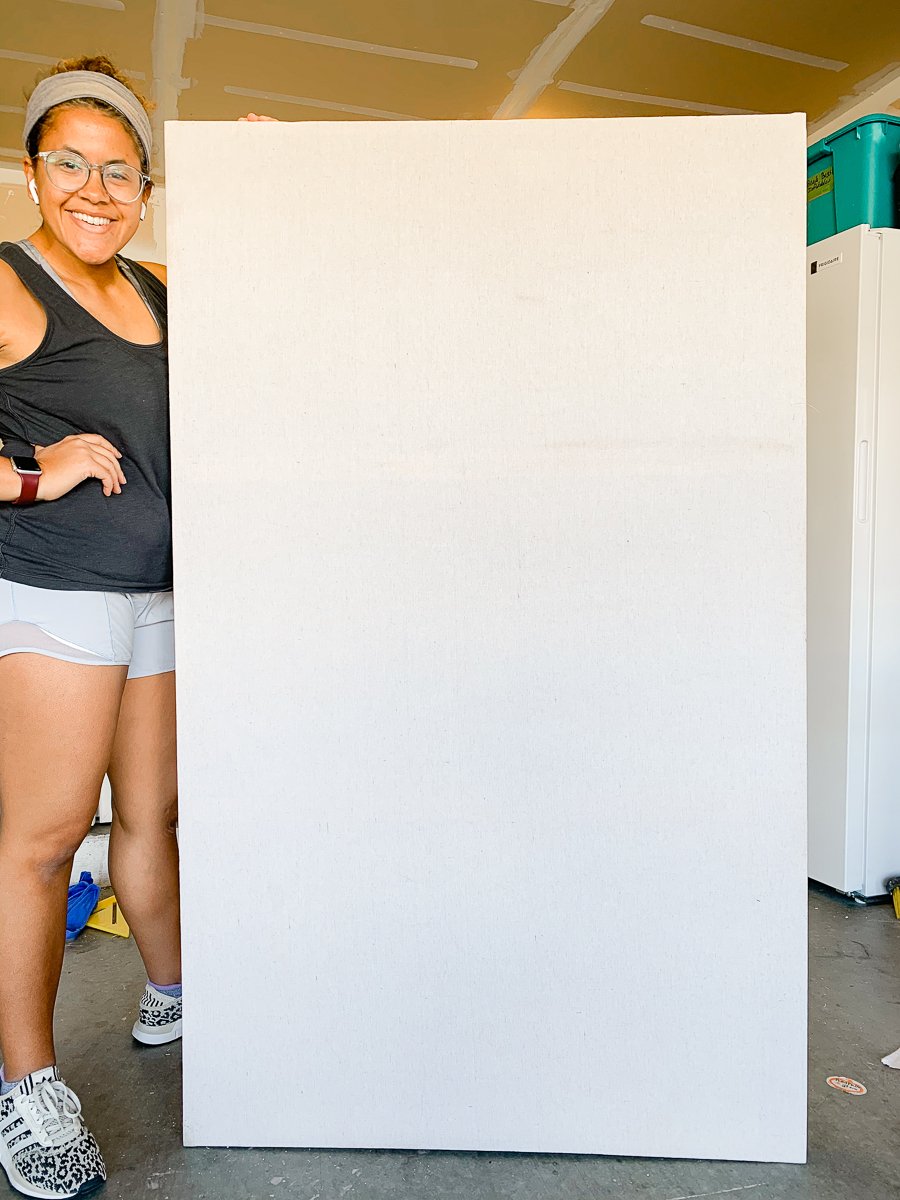
Now you tin can stand up it up and adore your piece of work! Kidding, now it'due south fourth dimension to paint – this is a DIY sail painting, after all.
Here'south Part two: How to Paint an abstract canvas
Of form, at this point, you tin do whatever painting yous'd like but I'll share with yous my super technical (read not technical at all) artistic tutorial of what I did next to give yous some inspiration.
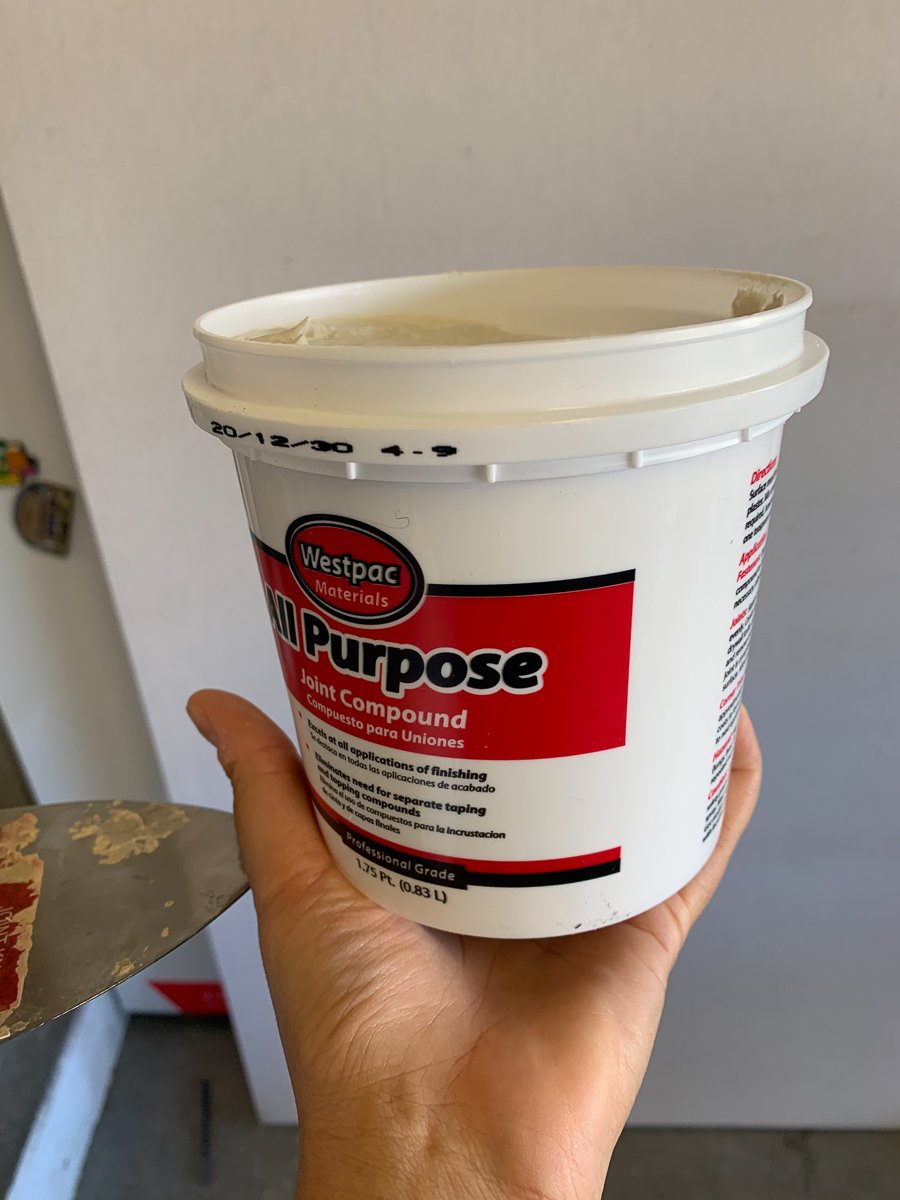
The textile of the driblet material, while thick, does not accept a super tight weave so if you lot were to paint directly on it, it would probably need several coats. You tin can also add a coat of primer or gesso. I planned on adding some texture to my painting from the beginning so I first added a layer of joint chemical compound.
I'm really glad I did because I think it really helped with the overall look of the painting.
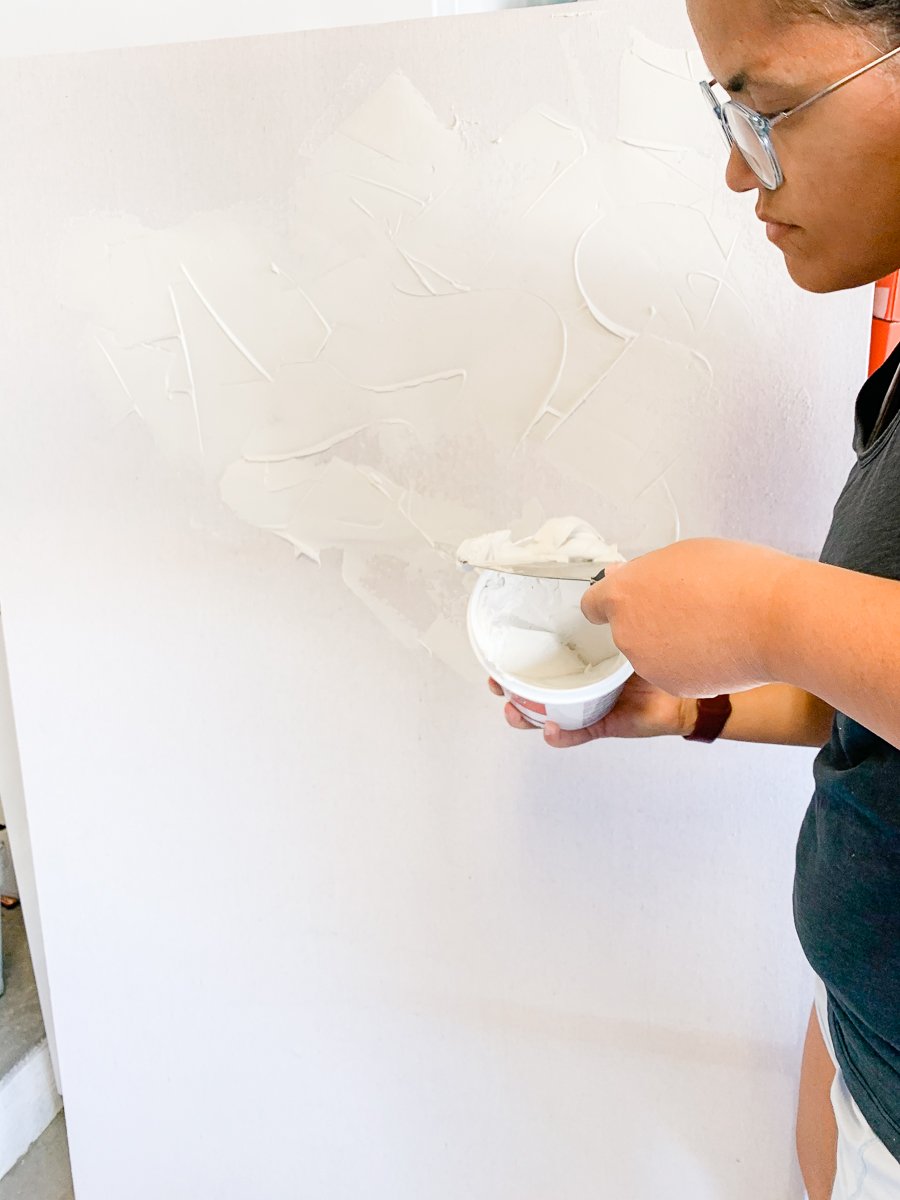
With a two-inch-broad putty pocketknife, I smeared the articulation compound all over the canvas. I was really liberal with the joint compound. Leaving some thicker lines of information technology in places and keeping it a little clearer in other spots.

Afterward the articulation compound dried, I came back with some dark blue paint. I just used these foam brushes considering information technology's what I had on hand. I painted the entire sheet with a layer of blue.
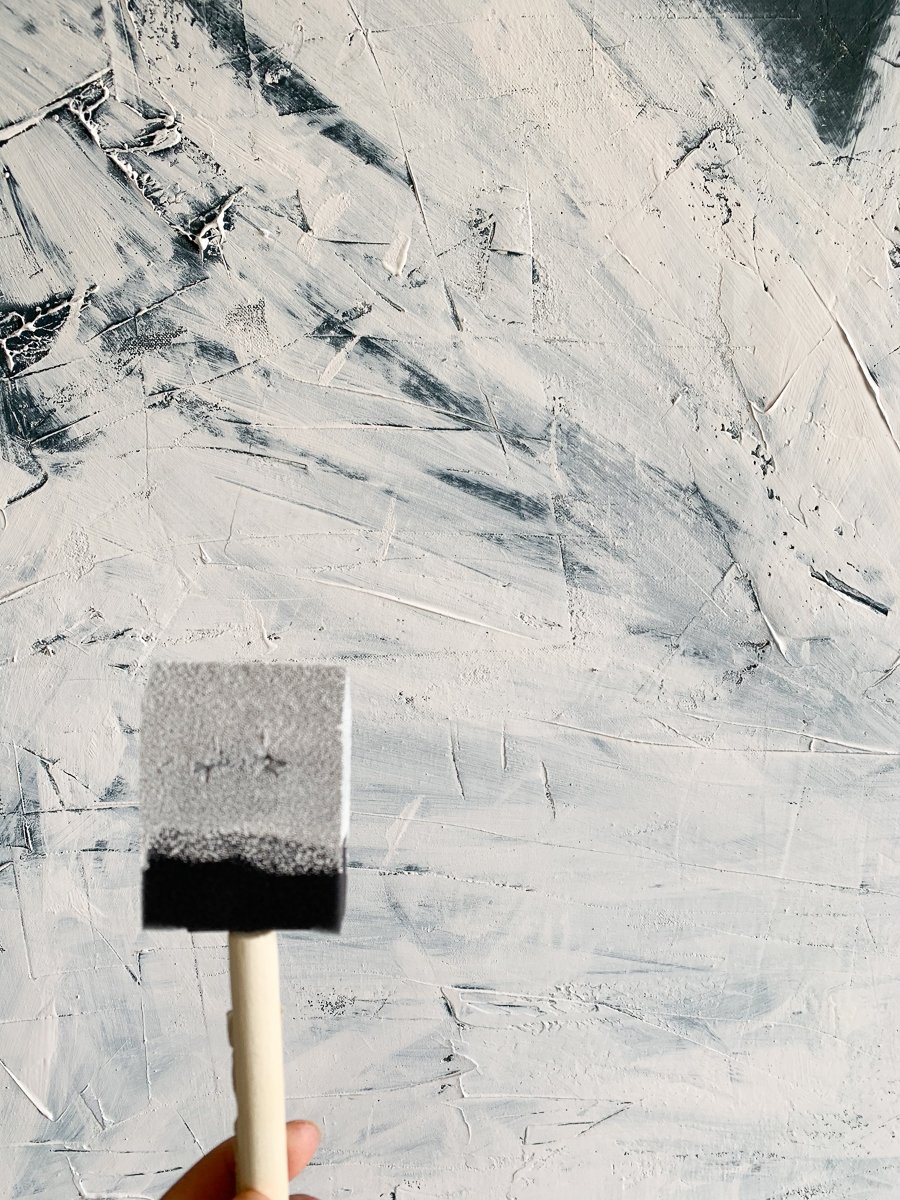
Afterwards a layer of blue, I painted over it with a layer of white. Then, another layer of a light beige-y white. Several times I came dorsum with the previous color to add together a little more in some spaces until I got a layered base of operations that I really liked. Afterward that, I added the loopy swirls. I used a small paintbrush and just gratuitous-handed the loops.
My first try at this, I didn't like and then I painted over information technology again with the beige-y white and started over with the loopy swirls, and that fourth dimension I got it right. Information technology was a perfect piece of art.
We framed the canvas using a simple mitered corner technique that is featured in this DIY canvas frame tutorial. The only deviation is, this time nosotros used the brad nailer and finishing nails to actually attach the canvas to the frame instead of allowing information technology to just fit snugly effectually.

We used a combination of these two stains I found at Home Depot. First applying the stain Special Walnut, followed upwards Sunbleached.

In the photograph above you tin run across the Special Walnut earlier adding the Sunbleached on the bottom there. On the height, the Sunbleached color has been applied on tiptop of the Special Walnut stain.
I'm so thrilled with how it turned out. This painting is and so perfect in this space and I recollect it elevates the entire room.
It'south one of those things where yous didn't know how much you needed information technology until you have information technology.
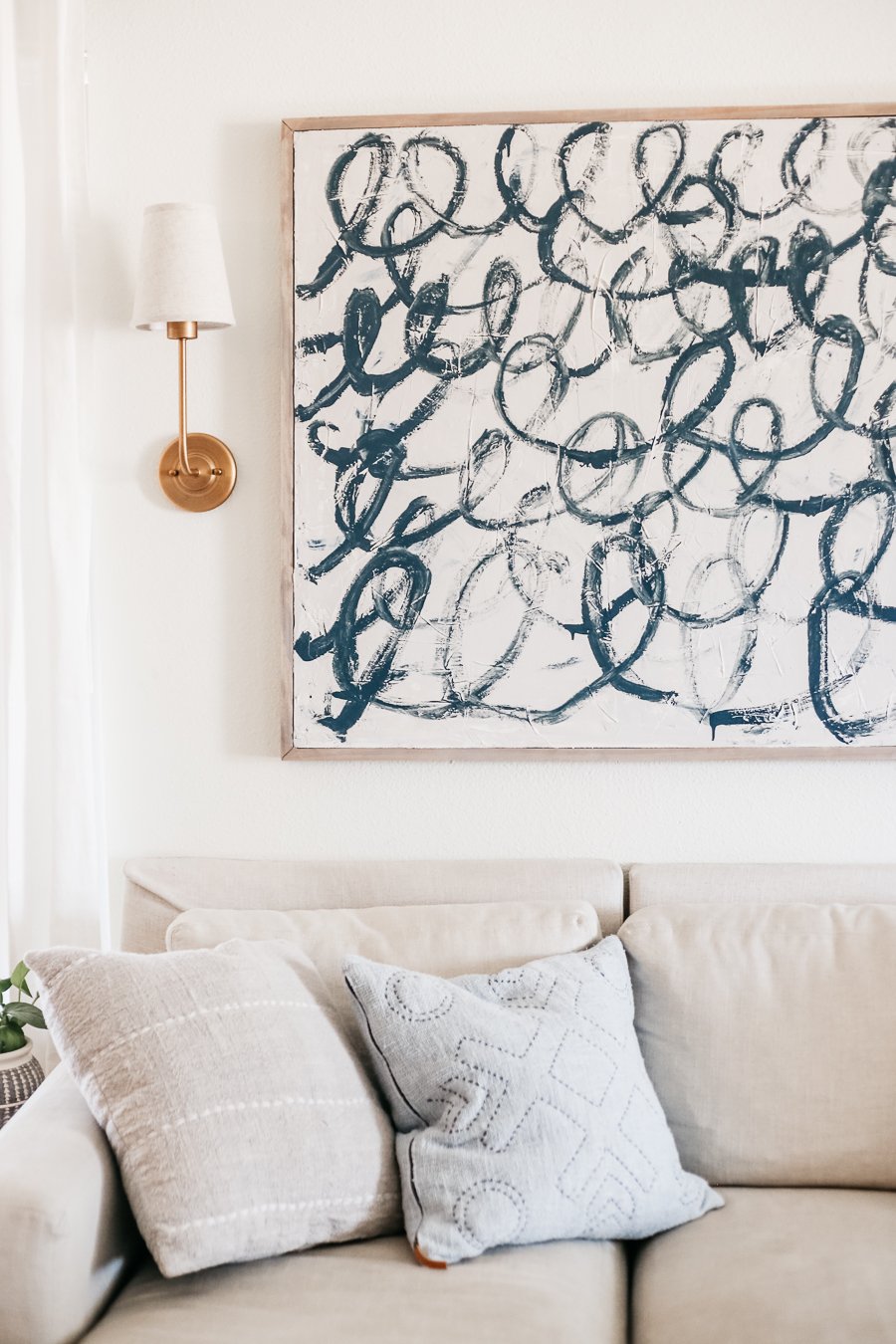
Can you lot believe I fabricated that? I made that!

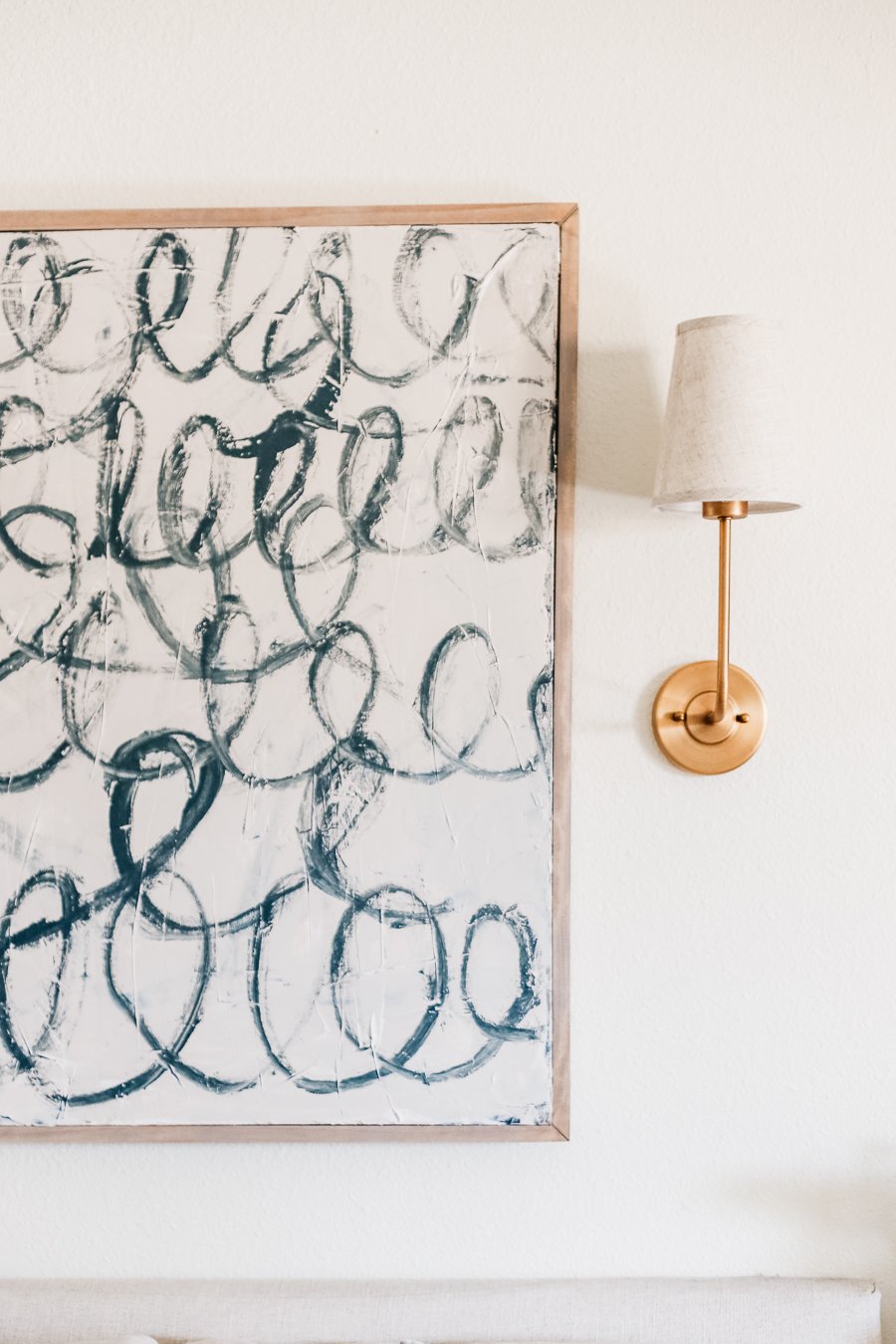

For your convenience, this mail service may incorporate affiliate links. That means, at no additional price to you, I may brand a small commission on your purchase. Click here to read my full disclosure policy


Have you ever washed a projection similar this before? I'd love to hear nearly it.
I'd dearest for you lot to share this on Pinterest or Instagram. You can follow me: @makinghomebase. You can also just transport this link to someone you think will enjoy information technology! I appreciate you lot sharing my projects!
You can also check out my other DIY fine art projects beneath:

DIY Abstract Fine art from Plywood

DIY Wall hanging from Wrapping Paper
Source: https://www.makinghomebase.com/diy-canvas-painting-with-an-actual-diy-canvas/
0 Response to "How to Diy Large Scale Canvas Doy Large Scale Art"
Post a Comment